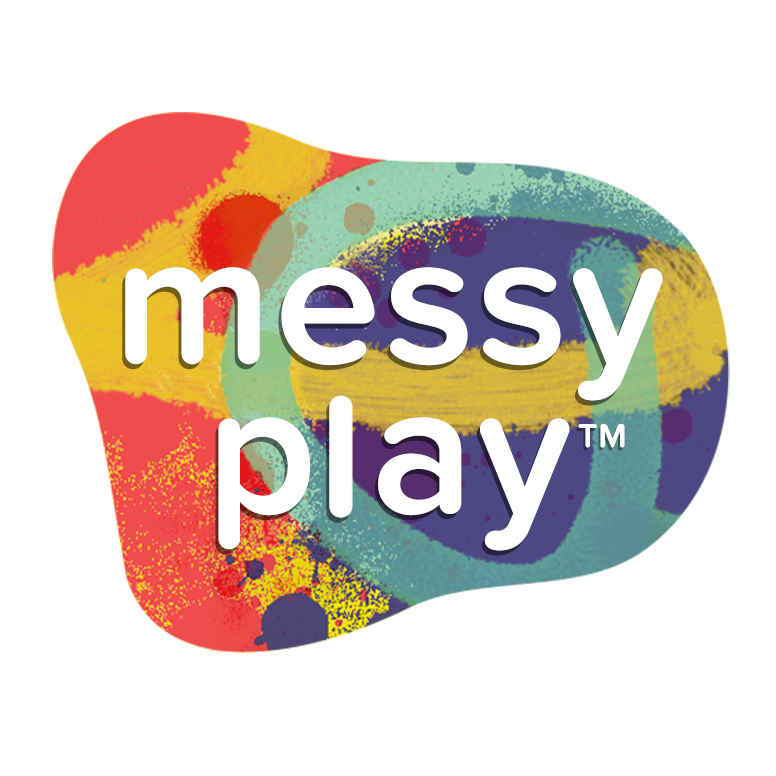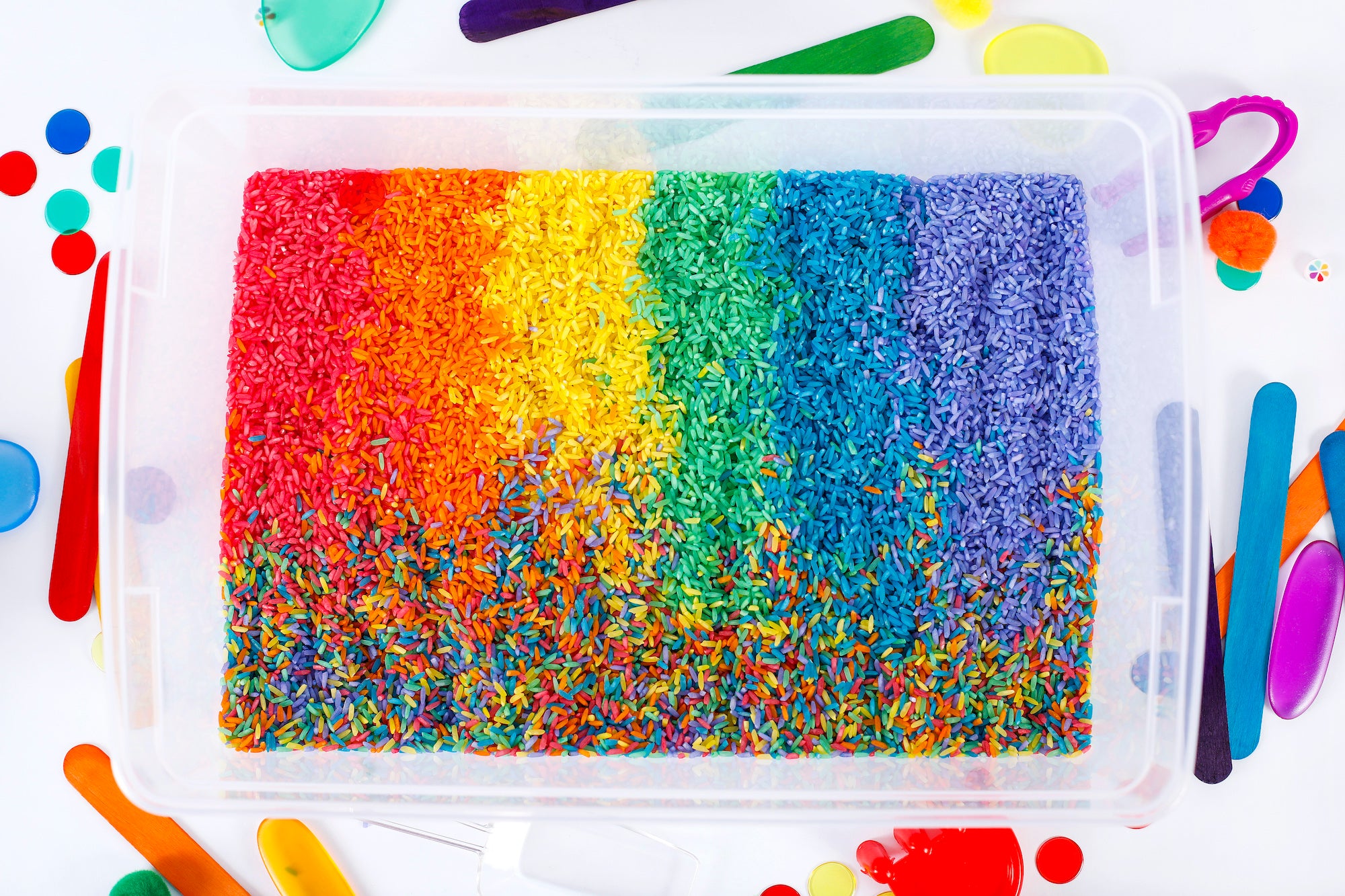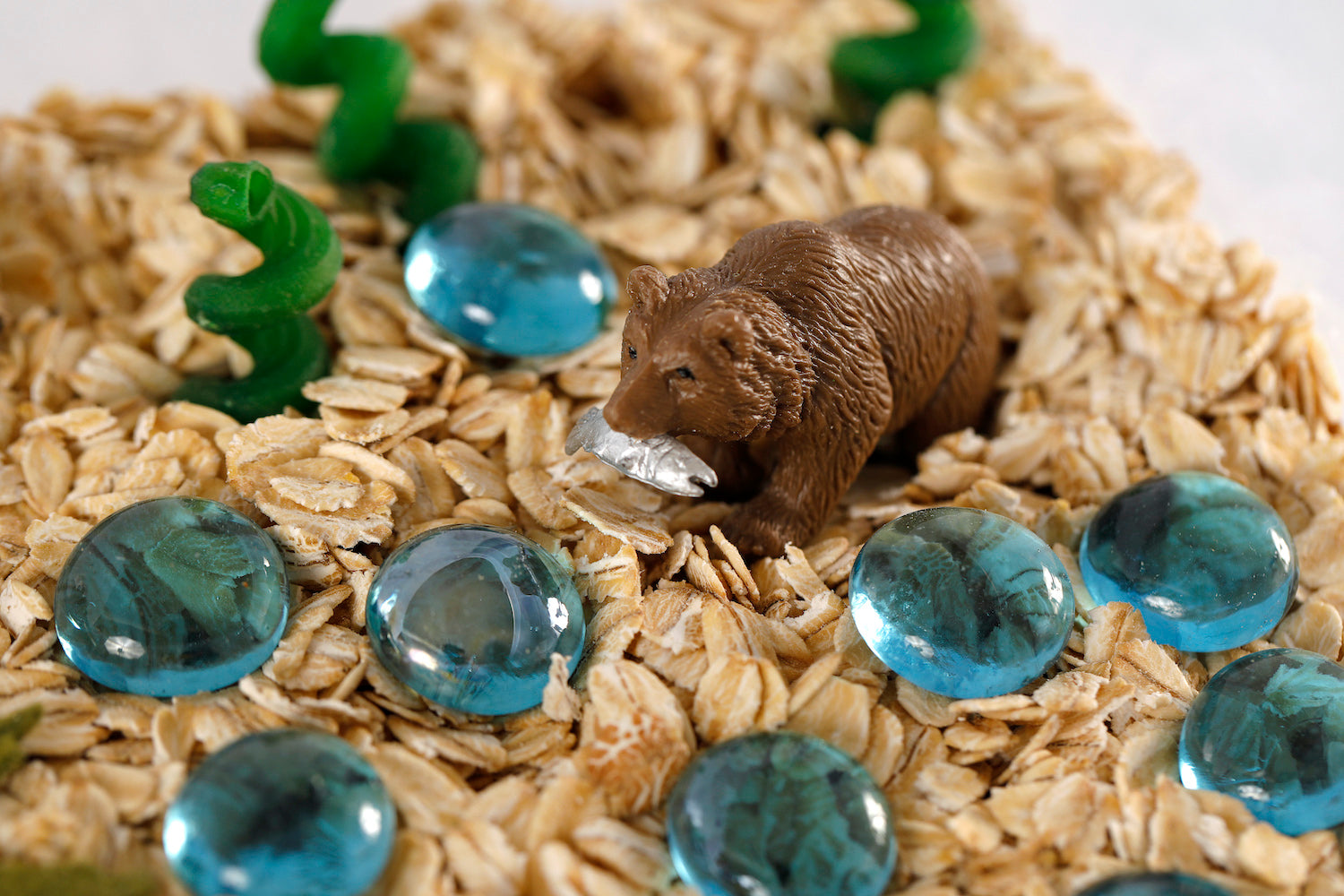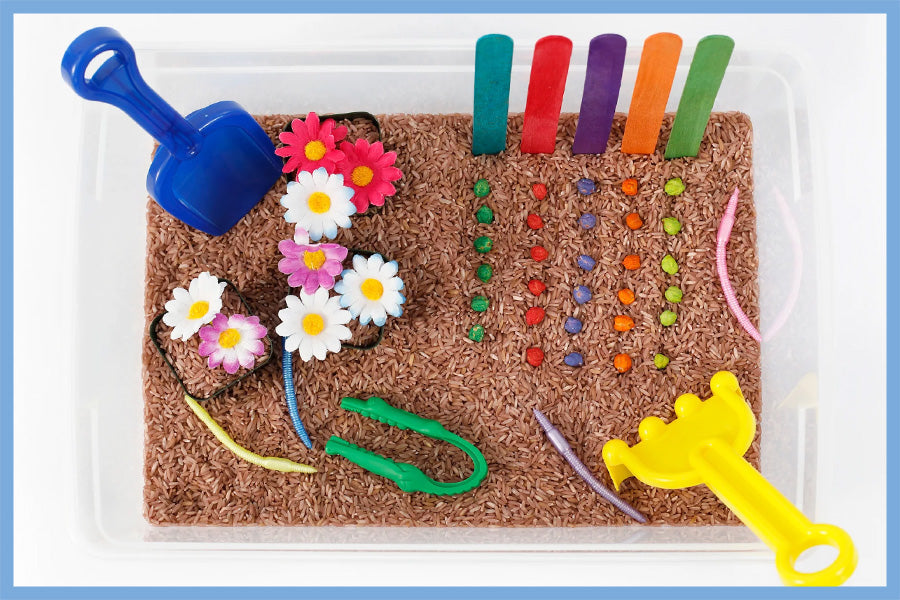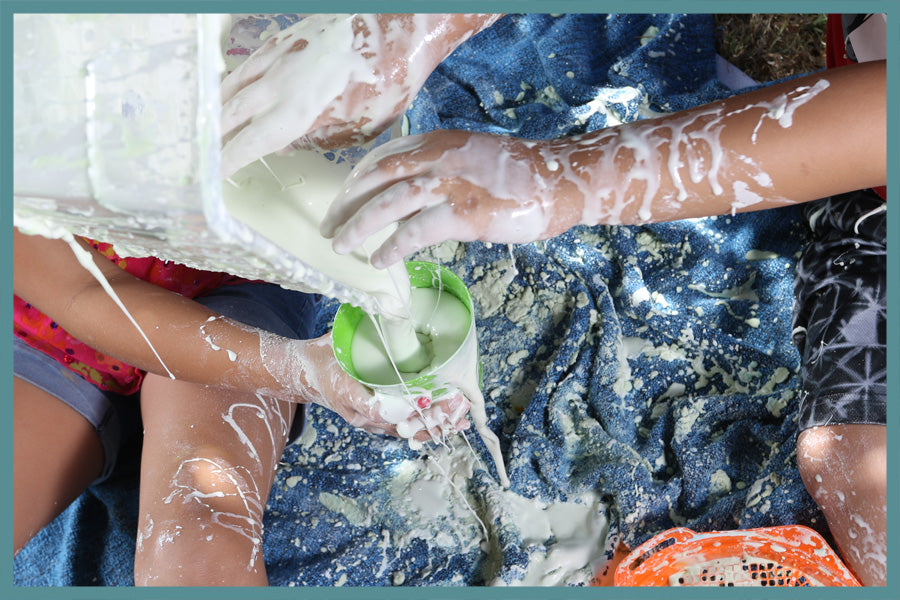Safe and Unsafe Sensory Materials for the Base of Your Sensory Bin
Why Sensory Bin Beans Are Unsafe & the Benefits of Better Alternatives
The benefits of sensory bins for children have been proven by experts. They can improve fine motor skills, invite sensory exploration, promote intellectual and language development, and provide calming experiences that help your kids to regulate. These foundational benefits will serve your children well into adulthood. However, the sensory materials used within the bins can either be helpful or harmful for children. For example, sensory bin beans are unsafe because raw or undercooked beans are toxic, while the benefits of rice sensory play are numerous!
Messy Play Kits strives to be the place to offer the best and safest sensory play ideas. So, if you’re going to make your own sensory bin at home or for your classroom, or purchase one from a retailer like my Monthly Sensory Bin Subscription, please ensure that they are made of only the safest sensory materials.
How to Choose the Best Sensory Materials for Your Bin
Some links below are affiliate links. When you buy through our links, we may earn a commission. Learn more →
Age-Appropriate Materials
Before making or buying a sensory bin, first think about age-appropriateness and your child’s current abilities.
Baby
Has your baby been introduced to food yet? If not, water and ice are great sensory materials, or you can try sensory bottles and sensory bags.
Toddler
Are your toddlers still putting everything in their mouths? If so, your sensory bin can’t have any choking hazards and should only include sensory materials that are safe to eat raw in small quantities. One sensory play tip I love to offer for caregivers raising children in this stage of development is to feed your kiddo before they play, so they’re less tempted to consume the base materials as food.
Dry Versus Wet Materials
You can also use dry or wet sensory materials for the base of your bins. One benefit of dry ingredients is the ability to put a lid on the bin and store it away for repeated play experiences. While wet sensory materials can provide for fun, mushy, and messy sensory opportunities, they should only be used a few times, storing them in the fridge for a few days before discarding them.
The Problem with Sensory Bin Beans
Although sensory bin beans are popular, please, don’t use them as play materials with your children. Again, eating raw or undercooked beans can be toxic and cause food poisoning, including symptoms such as nausea, vomiting and diarrhea. However, there are a number of other sensory materials that you can use instead.
Water Beads are Unsafe
Water beads can be a choking hazard and fatal if swallowed. If you choose to use these, please do so carefully by making sure your little one doesn't put them in their mouth, especially before they're full sized.
The Benefits of Rice Sensory Play
Personally, I love throwing rice into the bases of my sensory bins. Rice has a great texture, it naturally comes in different colors, it can be eaten safely in small quantities, and can be dyed a number of other fun colors to stimulate your kiddos’ imaginations! I use liquid watercolors to dye my rice. It’s like food coloring but nontoxic and washable! These are just some of many benefits of rice sensory play. My Rainbow Sensory Bin shows how rice can be dyed in a variety of colors and organized, helping your kiddos to practice creating systematic solutions to problem solving by making order out of disorder.
The Best Dry Sensory Materials for Your Bin
After rice, there are a number of other dry sensory materials that can be used as the sensory bin filler that invite your kiddo into the wonderful world of sensory stimulation and creative imagination! With proper storage, your kiddo can use these sensory bins again and again! Here is a list of dry sensory materials that you can use for the base of your bins:
Rice

I know I’ve already raved about rice, but I just can’t talk enough about the benefits of rice sensory play. Rice is affordable, accessible, and reusable. Also, there are so many different kinds of rice! You can use brown rice, white rice, black rice, or wild rice. Or you can use a variety of rice types and mix them all up! If you’re worried about rice being poured out all over your table or floor, take a look at my Washable Dropcloth to help contain the mess.
Chickpeas
Dried chickpeas, also known as garbanzo beans, are a great replacement for sensory bin beans. They’re hard and circular. They have a light tan color that can replicate sand or desert landscapes. Let your little create a safari-themed sensory bin or a beach escape! Or you can dye them different colors and use them as seeds like I do in my Gardening Sensory Bin and the Galactic Sensory Bin. Your little ones can practice organizing them in rows just like they would real fruits and vegetables!
Oats
Dry oats is another fun sensory material for the base of your bin. Soft and light brown, it can also be used as a great replacement for the ground or dirt! Your child will love creating a sensory environment with trees, bees, bugs, and other plants. Check out my Forest Sensory Bin for a great example of how to use oats as a sensory bin base.
Cornmeal
The yellow color of cornmeal can also replicate sand! See how I use it in my Pirate Sensory Bin alongside shells, coins, gems and great beach toys for scooping. Cornmeal can also be dyed to reflect grassy environments. My Sports Sensory Bin includes green-dyed cornmeal mixed with toy sports balls, pipe cleaners to use as boundary markers, and even a rake to reshape the play space. Lastly, my Dinosaur Excavation Sensory Bin uses cornmeal that covers dinosaur toys for a fun archeological dig!
Lentils
Lentils make for a great neutral-colored sensory bin base. This sensory material can help the other objects in the bin stand out! Think archeological digs with hidden fossils, animals, and plants. Or, I use it in my Magnetic Sensory Bin to invite kids to find metal objects that will attach to the magnet like a sand treasure hunt!
Dried Pasta

Different types of dried pasta can be combined to create a colorful and diverse sensory bin base! The various shapes can represent other things like bowties can be butterflies, while penne can reflect caterpillars. That’s exactly what I did in my Butterflies & Bugs Sensory Bin. I also used black bowtie pasta as bats mixed with orange small shell pasta to mimic pumpkins in my Halloween Sensory Bin.
Popcorn Kernels
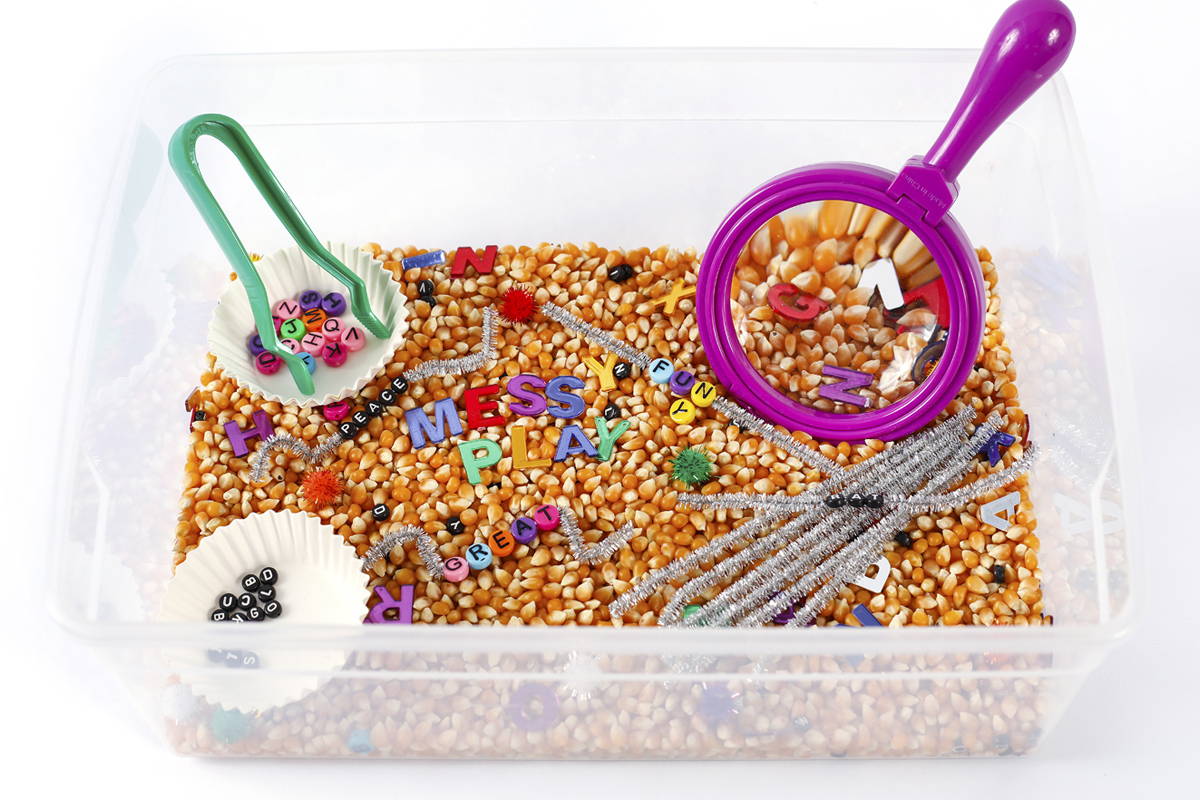
Both my Farm Sensory Bin and my Alphabet Sensory Bin use popcorn kernels as a part of their bases. The bright yellow, shiny color and hard texture make this a durable and beautiful sensory material for the base of bins.
Decaf coffee grounds
Coffee grounds (make sure they’re decaf!) are another fun way to create a sensory bin base. From black sand to volcanic ash, this dark sensory material will keep your kids engaged all day!
Split Peas
The natural green color of split peas makes for a great grass replacement. Add some play plates, cutlery, toy food, plants, and bugs and have a picnic! Check out my Picnic Sensory Bin as a fun example.
Black Eyed Peas
Black Eyed-Peas (the food not the band!) are technically beans. However, unlike other sensory bin beans, they are safe to eat raw. Be careful though, as eating too many can cause digestive discomfort. They can be a great sensory material because they’re naturally multi-colored!
Magic Sand
Magic Sand, also called Kinetic Sand™, is such a fun sensory play material! It’s sand that’s slightly magnetic, so will stick together a little better. This enables kids to shape and sculpt the sand into fun objects without using liquid. This will allow the sensory bin to be used over and over again!
Dry Cereal

Dry cereal is another fun way to introduce your child to sensory play. It’s crunchy and comes in so many shapes, colors, and tastes depending on your child’s preferences! And what a great way to use up old, stale cereal!
The Best Wet Sensory Materials for Your Bin
Wet sensory materials provide messy and stimulating creative playtime for your child, which helps with their brain development. Although most wet bases should only be used once or a few times, storing in the refrigerator in between, they are such a great way to engage your kids in creative play. If you’re concerned about keeping the mess contained, check out my blog post with some tips and tricks on how to do so. You can also purchase the Mess Maker Apron to protect your kiddos’ clothes. Here are some of my favorite options for wet sensory materials:
Water
Water is a great sensory material for all ages! If your child loves the water, babies, toddlers, and preschoolers will all benefit from water play. Water can be poured into a sensory bin with other age-appropriate objects that are different weights. This will teach children about buoyancy and density. Kids can also learn about volume by practicing pouring!
Ice

Ice, although cold, can be another great way to use water in a different shape! You can teach children about the science of ice and how the element of water changes depending upon temperature. Add colored ice cubes to your bath time, freeze toy animals in muffin tins with water, or freeze water balloons. Or you can even make your own ice spaghetti monster!
Oobleck
Oobleck is such a fun way to show children how some sensory materials are non-Newtonian fluids, meaning they can have the properties of liquids and solids simultaneously! You can buy an Oobleck Kit so you can create and color oobleck from scratch (an additional sensory play activity!) from Messy Play Kits or make it at home with cornstarch, water, and liquid food coloring.
Gelatin
Depending on your religious observances or dietary preferences, gelatin can be used as a smooshy sensory material. It’s safe to consume and comes in all sorts of fun colors! It can also be cut into a bunch of different shapes with cookie cutters. If you’re seeking a vegetarian or vegan gelatin replacement, check out these four gelatin substitutes. Here are some Kosher gelatin options as well.

Cooked Pasta
Cooked pasta can also be used as a great sensory bin base. However, it will need to be refrigerated after each use and then discarded after a few days. The squishy and edible nature of this sensory material will keep your kids engaged!
Pudding
Pudding has a variety of flavors, tastes delicious, and is great for messy, gooey sensory play. It can be a great mimic to mud and mixed with objects that your child might find in the ground like worms!
Applesauce
Applesauce is one of my favorite sensory materials for babies who have been introduced to food. It’s a tasty, sweet treat that your kiddo can get all over their faces and trays, practicing olfactory and taste sensory play.
Instant Snow
Instant Snow is a really amazing sensory material. It starts off a powder, but when you add water, it immediately grows up to hundreds of times the size! A little bit truly goes a long way. We use this in our Arctic and Coral Reef Sensory Bins, as well as a filler for the snow globe in the Winter Sensory Bottle Pack. You can also buy it here and add your own toys and tools!
A Monthly Bin Subscription: Sensory Materials Included

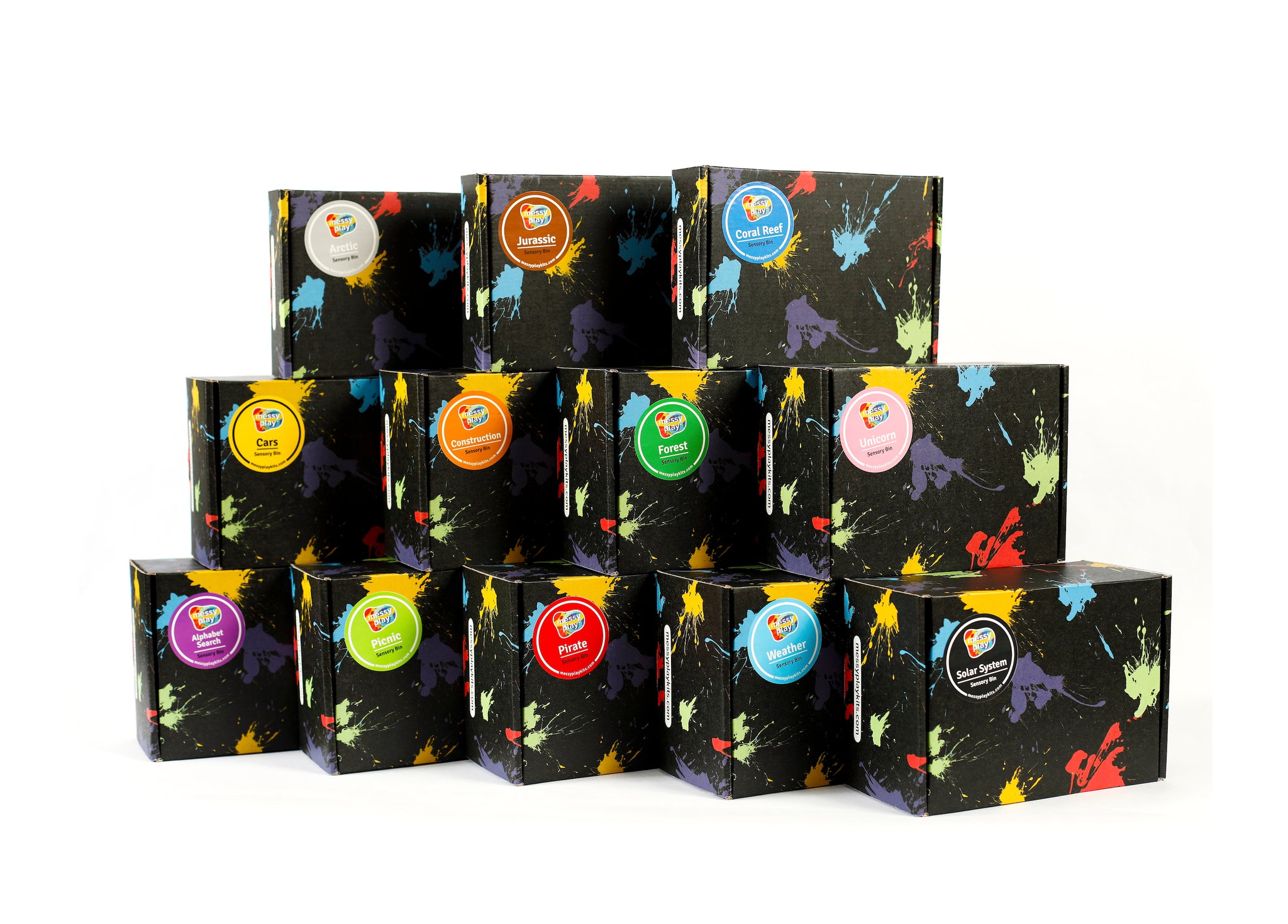
All of the sensory bins I introduced above are included in my Messy Play Kits Monthly Sensory Bin Subscription. If you want a box of reusable and themed sensory materials sent to your doorstep every month, so that you don’t have to go through the hassle of buying, dying, and combining sensory materials, subscribe today! I also sell individual sensory bins when I make too many for my subscription orders, so check out which ones are available now.
If you want to make your own sensory bins at home or for your classroom, remember to toss out those sensory bin beans and instead let your little ones enjoy the benefits of rice sensory play and other wet and dry sensory play resources like water beads and oatmeal. As always, enjoy the mess!
